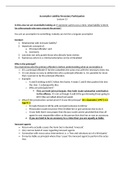Evolutionary Foundations of
Behaviour
Lectures: Basics in evolutionary and evolutionary
psychology
Mechanisms of evolution
Why evolutionary foundations?
- Investigate the origins of human brains, body, cognitive and emotional functions, and
behaviour
o Ask ‘why’ instead of ‘how’
Evolution by natural selection:
- Naturalist Charles Darwin
- He noticed that species seem to be designed for their natural habitats
- New idea! Species gradually change over many generations: ‘descent with
modification’ (over time different species adapt to their environment to fit it)
- Survival of the form (species that best fit to the environment) will leave copies of
itself in successive generations
Darwin’s finches:
- Finches with different beaks and sizes gradually evolved supporting an adaptive
function
- Triggered the idea of shared ancestry of all life forms
,Longitudinal study:
- Changes in beak size already after 25 years (evolved over time)
- Feeding tubes helps birds to be more efficient in obtaining food birds have better
chances of survival selection longer beak size
- Genes similar to human DNA influencing facial dysmorphism
- RFID tagging revealed greater use of bird feeders in birds with long bills
, Evolution by natural selection:
1. Variation: organisms within populations vary (e.g., traits)
2. Differential fitness: this variation affects the ability of organisms to survive and
reproduce (benefit in certain circumstances)
3. Heritability: variations are transmitted from parents to offspring (i.e., genes)
Behaviour
Lectures: Basics in evolutionary and evolutionary
psychology
Mechanisms of evolution
Why evolutionary foundations?
- Investigate the origins of human brains, body, cognitive and emotional functions, and
behaviour
o Ask ‘why’ instead of ‘how’
Evolution by natural selection:
- Naturalist Charles Darwin
- He noticed that species seem to be designed for their natural habitats
- New idea! Species gradually change over many generations: ‘descent with
modification’ (over time different species adapt to their environment to fit it)
- Survival of the form (species that best fit to the environment) will leave copies of
itself in successive generations
Darwin’s finches:
- Finches with different beaks and sizes gradually evolved supporting an adaptive
function
- Triggered the idea of shared ancestry of all life forms
,Longitudinal study:
- Changes in beak size already after 25 years (evolved over time)
- Feeding tubes helps birds to be more efficient in obtaining food birds have better
chances of survival selection longer beak size
- Genes similar to human DNA influencing facial dysmorphism
- RFID tagging revealed greater use of bird feeders in birds with long bills
, Evolution by natural selection:
1. Variation: organisms within populations vary (e.g., traits)
2. Differential fitness: this variation affects the ability of organisms to survive and
reproduce (benefit in certain circumstances)
3. Heritability: variations are transmitted from parents to offspring (i.e., genes)












